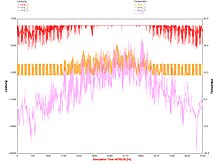TRNSYS
TRNSYS (abbreviated: TRaNsient SYstems Simulation; German for example: unsteady system simulation) is a tool for simulating systems and buildings. The program was developed in 1975 at the University of Wisconsin to simulate a solar system. Fortran was used for programming . The modular structure of the application enables a variety of problems to be solved. In addition to the simulation of solar systems, the program has established itself above all in the area of low-energy houses, technical systems such as ventilation devices, heat pumps , cooling machines and heating systems, as well as combined heat and power plants and fuel cells .
application
A main area of application is thermal-energetic building simulation . After entering the geometries and boundary conditions of one or more building zones, a statement about the temperature in the zones can be made with the help of a weather data set for the building. This is informative for the design of sun protection devices, windows or cooling systems. The use of solar energy and the heating requirement can thus be optimized. Furthermore, the simulation enables the design and optimization of control strategies e.g. B. the sun protection control or natural night ventilation. The results (room temperatures and heat demand) are output graphically. These results as well as peak heating and cooling loads and energy requirements are also output in ASCII format and can then be further processed (e.g. using a spreadsheet ).
